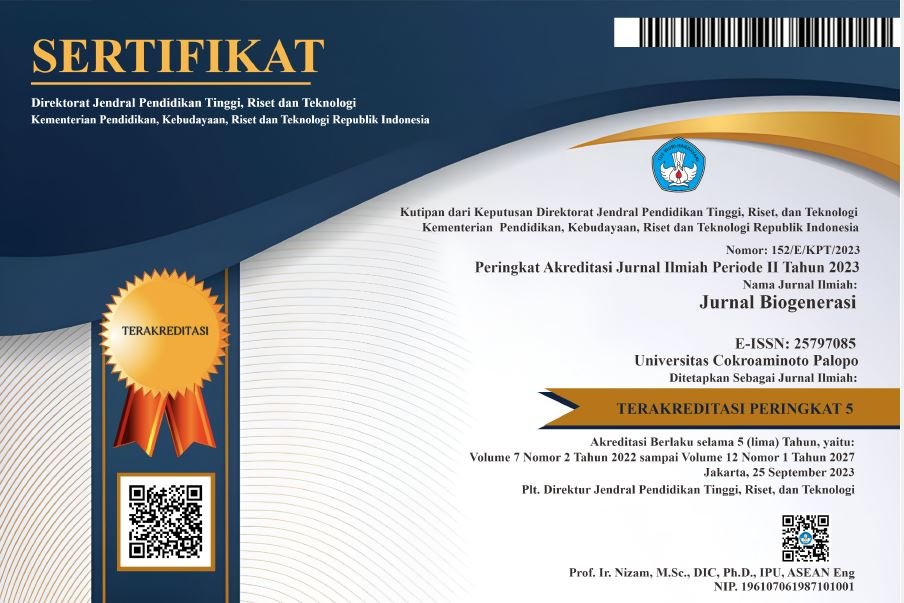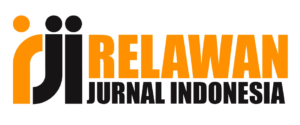a DESAIN HANDOUT STEAM@HOME BERBASIS TEAM BASE PROJECT PADA MATAKULIAH BIOTEKNOLOGI
DESAIN HANDOUT STEAM@HOME BERBASIS TEAM BASE PROJECT PADA MATAKULIAH BIOTEKNOLOGI
DOI:
https://doi.org/10.30605/biogenerasi.v8i1.2271Keywords:
steam@home, biothecnology, handout, team base projectAbstract
Innovation efforts in the development of teaching materials have been carried out through development research procedures with the ADDIE development model (Analysis, Design, Development, Implementation and Evaluation) in the Biotechnology course. This study aims to develop STEM-based handouts on the concept of Fermentation, determine the validity of STEM-based handouts based on the feasibility aspects of content, presentation, language, STEM and graphics, and determine user responses to STEM-based handout products. The results of this development indicate that STEM-based handouts are feasible to use with a feasibility assessment by experts of 83.61%. For user responses from 6th semester students of Biology Education Study Program, it is known that STEM-based handout products can be used in Biotechnology learning with a score of 73.71%. Recommendations from this research need to improve the design with STEM characteristics in technology and engineering aspects as well as more detailed mathematics.
Downloads
References
Andrianti, Y., dkk. (2016). Pengembangan Media Powtoon Berbasis Audiovisual pada Pembelajaran Sejarah. Jurnal Criksetra. 5(9): 58-68.
Arikunto, S. (2012). Prosedur Penelitian Suatu Pendekaatan Praktek. Jakarta: PT Rineka Cipta.
Arlitasari, O., dkk. (2013). Pengembangan Bahan Ajar IPA Terpadu Berbasis Salingtemas dengan Tema Biomassa Sumber Energi Alternatif Terbarukan. Jurnal Pendidikan Fisika. 1(1): 81-89.
Daryanto. (2013). Media Pembelajaran. Yogyakarta: Gava Media. Depdiknas. (2008). Panduan Pengembangan Bahan Ajar. Jakarta: Depdiknas.
Devan, J. (2016). Cities: Key Concepts and an Analytical Framework. Disajikan dalam Pertemuan Dewan Forum Ekonomi Dunia membahas Daya Saing, Juni 2016, Switzerland.
Dewi, H.R., dkk. (2017). Peningkatan Keterampilan Berpikir Kreatif Siswa Melalui Penerapan Inkuiri Terbimbing Berbasis STEM. Disajikan dalam Seminar Nasional Pendidikan Fisika III, 15 Juli 2017.
Kementrian Pendidikan dan Kebudayaan. (2017). Model Silabus Mata Pelajaran SekolahMenegah atas/Madrasah Aliyah (SMA/MA). Jakarta
Jufri, A. W., & Hikmawati, H. (2014). Analisis Kemelekan Sains (Science Literacy) Dan Kemelekan Inkuiri (Inquiry Literacy) Guru Mata Pelajaran IPA SMP. Jurnal Pijar Mipa, 9(1).
Rachmawati, D., Suhery, T., & Anom, K. (2017). Pengembangan modul kimia dasar berbasis STEM problem based learning pada materi laju reaksi untuk mahasiswa program studi pendidikan kimia. In Seminar Nasional Pendidikan IPA (Vol. 1, No. 1, pp. 239-248).
OECD. (2014). PISA in Focus : What 15 years old know and do with what they know
Pertiwi, R.S., Abbdurahman,. Rosidin, Undang. (2017). Efektifitas LKS STEM Untuk Melatih Keterampilan Berfikir Kreatif Siswa. Jurnal Fkip Universitas Lampung.
Muhammad Fatturahman. 2016. Model-model pembelajaran Inovatif. Yogyakarta : Arruz Media [9] Depdiknas, (2008). Panduan Pengembangan Bahan Ajar. Direktorat Jendral Manejemen Pendidikan Atas. Jakarta
Riyant0, Y. (2014). Paradigma Baru Pembelajaran. Jakarta : Prenada Media Group
Irma Suwarma, Astuti Puji dan Nur Endah. (2015). Ballon Powered Car “sebagai media pembelajaran IPA berbasis STEM (Science Technology Engineering Mathematic). 8 dan 9 Juni 2015. Prosinding Simposium Naisonal Inovasi dan Pembelajaran Sains. Bandung
Ismayani, A. (2016). Pengaruh Penerapan STEM Project Based Learning Terhadap Kreatifitas Matematis Siswa SMK. Indonesia Digital Journal of Mathematics and Education. Vol 3 (264-272) [13]Departement of Education and Skill Ireland. (2017). STEM Education Policy Steatment 2017-2026. Ireland
Khairiyah, N. (2019). Pendekatan STEM Referensi Standar untuk melakukan pembelajaran dikelas agar lebih efektif dan efesien. Medan: Guepedia
Gustiani, I., Widodo, A. , Suwarna, I.R. (2017). Development and Validation of STEM based Instructional Material. MSCEIS 2016.
Kementrian Pendidikan Malaysia. (2016). Panduan Pelaksanan Sains, Teknologi, Kejuruteraan, dan Matematik (STEM) dalam Pengajaran dan Pembela-jaran. PutraJaya
Utami, TN, Jatmiko, A dan Suherman. (2018). Pengembangan Modul Ma-tematika dengan Pendekatan Science, Technology, Engineering, and Math-ematics (STEM) pada Materi Segiempat. Jurnal Matematika 1(2):165-172. Universitas Islam Negeri Raden Intan. Lampung
Tung. (2016). Desain Instruksional Perbandingan Model dan Implementasinya. Yogyakarta : PT Andi
Riduwan. (2012). Skala Pengukuran VariabelVariabel Penelitian. Bandung : Alfabeta
Widyoko, EP. (2017). Teknik Penyusunan Instrumen Penelitian. Yogyakarta : Pustaka Belajar
Juniarti, Zubaidah, S. dan Koes, S. (2016). STEM: Apa, Mengapa dan Bagaimana? Prosinding Seminar Nasional Pendidikan Sarjana Pascasar-jana UM. Vol 1
Syukri, M., Halim, L., Meerah, T. S. M., & FKIP, U. (2013, March). Pendidikan STEM dalam Entrepreneurial Science Thinking ‘ESciT’: Satu Perkongsian Pengalaman dari UKM untuk ACEH. In Aceh Development International Conference (pp. 26-28).
Khoiriyah, N. (2018). Implementasi pendekatan pembelajaran STEM untuk meningkatkan kemampuan berpikir kritis siswa SMA pada materi gelombang bunyi
FKIP Universitas PGRI Madiun. Firman, H. (2016). Pendidikan STEM Sebagai Kerangka Inovasi Pembelajaran Kimia untuk Meningkatkan Daya Saing Bangsa dalam Era Masyarakat Ekonomi ASEAN. Disajikan dalam Prosiding Seminar Nasional Kimia dan Pembelajarannya, 17 September 2016. FMIPA Universitas Negeri Surabaya.
Firman, H. (2015). Pedidikan Sains Berbasis STEM: Konsep, Pengembangan, dan Peranan Riset Pascasarjana. Disampaikan pada Seminar Nasional Pendidikan IPA dan PLKH Universitas Pakuan,
Agustus 2015. Bandung: Universitas Pendidikan Indonesia. Kaniawati, D.S., dkk. (2015). Study Literasi Pengaruh Pengintegrasian Pendekatan STEM dalam Learning Cycle 5E terhadap Kemampuan Pemecahan Masalah Siswa pada Pembelajaran Fisika. Disajikan dalam Prosiding Seminar Nasional Fisika, 21 November 2015. UPI Bandung.
Laboy-Rush, D. (2010). Integrated STEM Education trhough Project-Based Learning. New York: Learning.com.
LaForce, M., dkk. (2016). The Eight Essential Elements of Inclusive STEM High Schools. International Journal of STEM Education. 3(21): 1-11.
Mustafa, N., dkk. (2016). A Meta-Analysis on Effective Strategies for Integrated STEM Education. Advanced Science Letters. 22(12): 4225-4228.
Pemanasari, A. (2016). STEM Education: Inovasi dalam Pembelajaran Sains. Disajikan dalam Prosiding Seminar Nasional Pendidikan Sains, 22 Oktober 2016. Surakarta.
Pertiwi, R.S. (2017). Pengembangan Lembar Kerja Siswa dengan Pendekatan STEM (Science, Technology, Engineering, Mathematics) untuk Melatih Keterampilan Berpikir Kreatif Siswapada Materi Fluida Statis. Tesis. FKIP Universitas Lampung.
Prastowo, A. (2012). Panduan Kreatif Membuat Bahan Ajar Inovatif. Jogjakarta: DIVA Press (Anggota IKAPI).
Prawiradilaga, S.D. (2008). Prinsip Desain Pembelajaran. Jakarta: Kencana Predana Media Group.
Pribadi, B.A. & Sjarif, E. (2010). Pendekatan Konstruktivistik dan Pengembangan Bahan Ajar pada Sistem Pendidikan Jarak Jauh. Jurnal Pendidikan Terbuka dan Jarak Jauh. 11(2): 117-128.
Ridwan Abdullah Sani. (2015). Pembelajaran Saintifik untuk Implementasi Kurikulum 2013. Jakarta : Bumi Aksara
Rahmiza, S., dkk. (2015). Pengembangan LKS STEM (Science, Technology, Engineering, and Mathematics) dalam Meningkatkan Motivasi dan Aktivitas Belajar Siswa SMA Negeri 1 Beutong pada Materi Induksi Elektromagnetik. Jurnal Pendidikan SainsIndonesia.3(1):1-9.
Sholikhakh, R.A., dkk. (2012). Pengembangan Perangkat Pembelajaran Beracuan Konstruktivisme dalam Kemasan CD Interaktif Kelas VIII Materi Geometri dan Pengukuran. Unnes Journal of Research Mathematics Education. 1(1): 13-19.
Sudijono, A. (2010). Pengantar Statistik Pendidikan. Jakarta: PT. Raja Grafindo Persada.
Sugiyono, S. (2010). Metode Penelitian Pendidikan Pendekatan Kuantitatif, Kualitatif, dan R&D. Bandung: Alfabeta.
Sugiyono, S. (2012). Metode Penelitian Pendidikan. Bandung: Alfabeta. Tessmer, M. (1993). Planning and Conducting Formative Evaluation. Routledge: London. World Economic Forum (WEF). (2016). Competitive Cities and Their Connections to Global Value Chains. Switzerland: WEF
Trianto. (2014). Mendesain Model Pembelajaran Inovatif-Progresif: Konsep Landasan dan Implementasi pada Kurikulum 2013. Jakarta: Prenada Media Group.
Downloads
Published
How to Cite
Issue
Section
License
In submitting the manuscript to the journal, the authors certify that:
- They are authorized by their co-authors to enter into these arrangements.
- The work described has not been formally published before, except in the form of an abstract or as part of a published lecture, review, thesis, or overlay journal.
- That it is not under consideration for publication elsewhere,
- That its publication has been approved by all the author(s) and by the responsible authorities – tacitly or explicitly – of the institutes where the work has been carried out.
- They secure the right to reproduce any material that has already been published or copyrighted elsewhere.
- They agree to the following license and copyright agreement.
License and Copyright Agreement
Authors who publish with this journal agree to the following terms:
- Authors retain copyright and grant the journal right of first publication with the work simultaneously licensed under Creative Commons Attribution License (CC BY 4.0) that allows others to share the work with an acknowledgment of the work's authorship and initial publication in this journal.
- Authors are able to enter into separate, additional contractual arrangements for the non-exclusive distribution of the journal's published version of the work (e.g., post it to an institutional repository or publish it in a book), with an acknowledgment of its initial publication in this journal.
- Authors are permitted and encouraged to post their work online (e.g., in institutional repositories or on their website) prior to and during the submission process, as it can lead to productive exchanges, as well as earlier and greater citation of published work.


.png)

